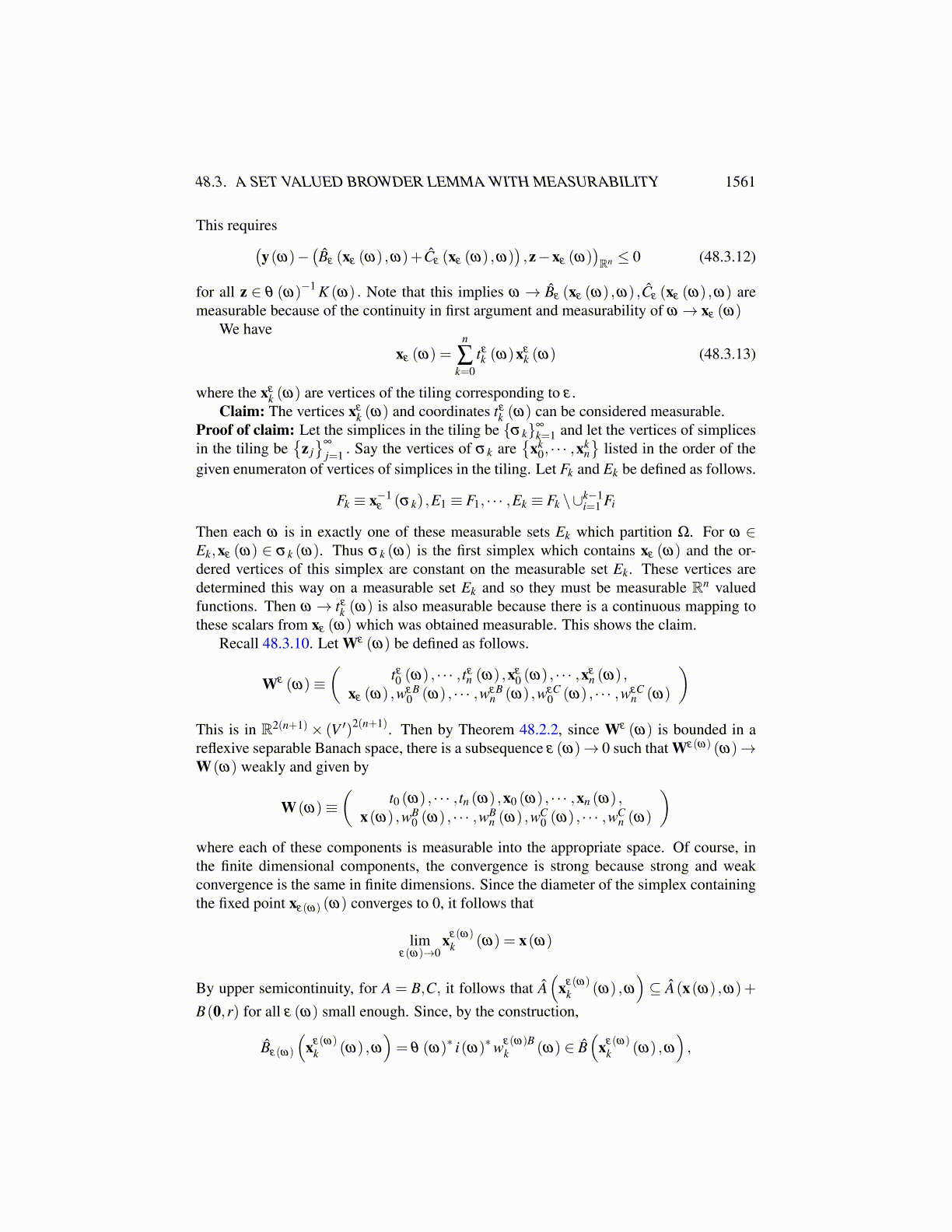
48.3. A SET VALUED BROWDER LEMMA WITH MEASURABILITY 1561
where A(·,ω) will be either B(·,ω) or C (·,ω). Here θ (ω)ei ≡ bi (ω) and extended lin-early. Then it is clear that θ (ω) maps measurable functions to measurable functions.
What of θ (ω)−1? Is ω→ θ (ω)−1 h(ω) measurable into Rn whenever h is measurableinto V ? Let h(ω) have values in E (ω) and be measurable into V . Thus
h(ω) = ∑i
ai (ω)bi (ω)
The question reduces to whether the ai are measurable. To see that these are measurable,consider first ∥h(ω)∥<M for all ω . Let Sr ≡
{ω : inf|a|>r ∥∑i aibi (ω)∥> M
}. Thus this is
a measurable set. Also every ω is in some Sr because if not, you could get a sequence |ar|→∞ and yet ∥∑i ar
i bi (ω)∥ ≤M. But then, dividing by |ar| and taking a suitable subsequence,one can obtain ∑i aibi (ω) = 0 for some |a| = 1. Also the Sr are increasing in r. Nowfor ω ∈ Sr, define Φ(a,ω) = −∥∑i aibi (ω)−h(ω)∥ where we will let |a| ≤ r+1. Since{bi (ω)} is a basis, there exists a(ω) such that Φ(a(ω) ,ω) = 0. This a must satisfy|a| ≤ r + 1 because if not, then you would have ∥∑i aibi (ω)∥ ≥ M since ω ∈ Sr. But∥∑i aibi (ω)∥= ∥h(ω)∥< M . Thus the maximum of a→Φ(a,ω) occurs on the compactset |a| ≤ r + 1 and is 0. By Kuratowski’s theorem, we have ω → a(ω) is measurablewhere h(ω) = ∑i ai (ω)bi (ω) on Sr. Thus, since every ω is in some Sr, we must haveω→ ai (ω) is measurable in case ∥h(ω)∥ ≤M for all ω . In the general case, let am (ω) bethe measurable function which goes with hm (ω) where hm (ω) is given by a truncation of hso that ∥hm (ω)∥ ≤ m. For each ω,hm (ω) is eventually smaller than m, so h(ω) = hm (ω).Thus if am
i (ω) go with hm (ω) , these are constant for all m large enough. Thus lettingai (ω)≡ limm→∞ am
i (ω) ,ai is measurable and
h(ω) = limm→∞
hm (ω) = limm→∞
∑i
ami (ω)bi (ω) = ∑
iai (ω)bi (ω)
and so the ai are indeed measurable. Thus the θ (ω)−1 h(ω) = ∑i ai (ω)ei which showsthat θ (ω)−1 does map measurable functions to measurable functions. In particular,
θ (ω)−1 K (ω)
is indeed a closed, bounded, convex, and measurable multifunction which can be seen byconsidering a sequence {ki (ω)}∞
i=1 of measurable functions dense in K (ω).Define for A = B or C,
Â(·,ω) = θ (ω)∗ i(ω)∗A(θ (ω) ·,ω) ,y(ω) = θ (ω)∗ i(ω)∗ y(ω) . (48.3.9)
We claim that ω → Â(x,ω) has a measurable selection and for fixed ω this is upper semi-continuous in x. The second condition for fixed ω is obvious. Consider the first. It wasshown above that θ (ω)x is measurable into V . Thus, by Theorem 48.3.1, it follows thatω → A(θ (ω)x,ω) has a measurable selection into V ′. Therefore, it suffices to show thatif z(ω) is measurable into V ′ then θ (ω)∗ i(ω)∗ z(ω) is measurable into Rn. Let w ∈ Rn.